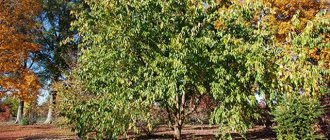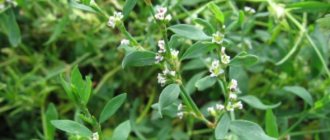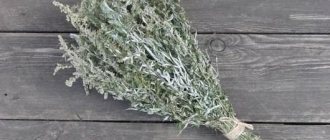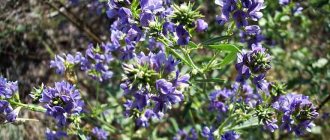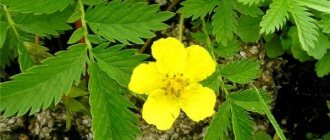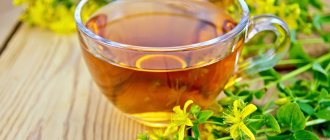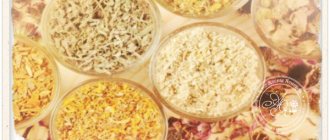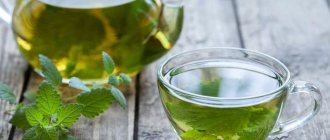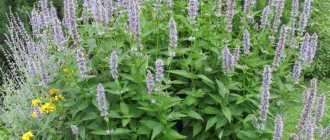Erva woolly, otherwise called half-palmed, is a herbaceous biennial from the Amaranthaceae family. The plant loves hot, humid climates. Its homeland is Sri Lanka; half of it also grows in African countries, Australia, India, New Guinea and Indonesia. It is not found in the wild on the territory of the Russian Federation. The medicinal properties and contraindications of pol-pal grass were known and widely used by healers of local tribes. It was these ancient recipes that formed the basis of modern treatment methods.
Comment! For Russians, the easiest way to find half-palmed grass is to purchase ready-made raw materials at a herbal pharmacy.
Chemical composition of half-burnt
Paula grass is a storehouse of substances beneficial to the human body. It rightfully occupies a leading position among medicinal herbs - thanks to its rich chemical composition. It contains the following substances:
- micro- and macroelements – calcium, potassium;
- indole alkaloids – methylervin and ervin, ervoside, ervolanine;
- flavonoids – acyl glycoside tiliroside, ervitrin, narcissin;
- phenolic acids;
- complete sugars, pectin;
- essential amino acids;
- alkanes, oleanoic acid;
- mineral salts.
Important! The herb contains a high percentage of potassium nitrate, which makes it an excellent potassium-sparing diuretic (diuretic).
The benefits of the herb are gone
Official medicine recommends treatment with pol-pal herb in the presence of urolithiasis and cholelithiasis. But herbalists are not limited to just the diuretic effects of the herb. Infusions, decoctions and teas with herbs have a beneficial effect on all organs and systems of the human body, restoring and normalizing their activity.
We recommend reading: Mint tea: beneficial properties and contraindications, how to make
The plant has the following properties:
- stabilizes heart function and normalizes blood pressure, improves blood clotting;
- restores natural water-salt balance;
- has antimicrobial, analgesic and anti-inflammatory effects;
- the half-burnt herb improves the regeneration of skin tissue and has a pronounced wound-healing effect;
- cleanses the body, removes toxins and waste products;
- strengthens the walls of blood vessels, prevents the appearance of atherosclerotic plaques, improves the functioning of the adrenal glands;
- restores a weakened body, tones, strengthens the immune system;
- normalizes hemoglobin levels, prevents the formation of stones and clots in the gallbladder and ducts, in the kidneys;
- has a pronounced antitumor effect and prevents the development of cancer cells.
Attention! According to statistics, cancer rates in Ceylon are consistently lower than in most countries in the world. Russian researchers attribute this fact to the frequent use of this herb as a medicine.
The herb is often used in the complex treatment of obesity at various stages
Medicinal properties of woolly erva
So, the medicinal properties of woolly erva relate to the following diseases and their complications.
- Urolithiasis disease. The grass half-palmed helps with it due to the diuretic properties of rhamnetin and the anti-inflammatory effect provided by the remaining bioflavonoids and alkaloids. Science has not yet determined exactly what leads to the appearance of stones in any organs - chronic inflammation, foreign bodies (calcium from bones, bacteria, etc.) or other factors. But it is already obvious that even one formed stone further provokes or maintains inflammation, only accelerating its own growth and the process of the appearance of “comrades”.
- Gallstones. Since reducing inflammation is the key to treating stones of any origin.
- Prostatitis and cystitis. This is a common prostate disease among men, which can occur at any age under the influence of hormonal imbalance (the most common cause), infection, or impaired blood supply to the pelvic organs. Prostatitis is accompanied by inflammatory processes in the tissues of the gland. And as they progress, a complication of prostatitis arises - cystitis. Secondary phenomena from the bladder are explained by the fact that the prostate gland encloses the urethra in a ring. The swelling of its tissues, both during sexual arousal and during prostatitis, leads to compression of the urethra, which provokes difficulties with its emptying. And the constant stagnation of urine in the bladder entails its inflammation. Treatment with half-finger with its pronounced antiseptic effect allows you to reduce the intensity of inflammatory reactions in all organs affected by them.
- Inflammation of the uterine appendages. The pathology is as widespread among women as prostatitis among men. And external washing and douching with preparations based on Erva woolly can be used to treat vulvitis and vaginitis.
- Gout and urate stones. Gout is a disorder of the metabolism of uric acid in the body, which causes the deposition of its crystals in the joint capsules and kidneys in the form of brick-red urate sand/stones. There is still debate about how much the development of gout may be related to renal failure or autoimmune processes. But the facts indicate that if it appears, the deterioration of kidney function with it is a matter of the coming years. And erva woolly helps not only to inhibit the formation of urate stones, but also to quickly remove uric acid from the blood. These two factors determine the use of Erva woolly for kidney stones of any other origin (oxalates, phosphates, cystines).
- High blood pressure. Pol-pal helps lower blood pressure due to its diuretic and anti-inflammatory effects.
- Diabetes. Taking the herb half-palmed does not replace insulin compensation. But it is suitable as an auxiliary means of controlling sugar levels and the rate of destruction of blood vessels by glucose.
Other effects of the grass
In addition to the listed indications for the use of woolly erva, there are others, but they raise more doubts. For example, among them is weight loss, as well as skin and hair care at home. Erva woolly does not help reduce the mass of adipose tissue even by one gram, but it allows you to remove more water from the body. And water makes up the lion's share of their visual volume and gives them a loose appearance.
Thus, as fluid is rapidly removed from the body, the needle on the weight-loss scale creeps down faster and faster, and the purely external volume of fat deposits decreases. In fact, both effects are false and lead to dehydration rather than to thinness.
As for the treatment of dead skin and hair with herbs, its therapeutic properties are due to the anti-inflammatory effect provided by the high content of alkaloids, bioflavonoids and food acids. But, firstly, it is better to apply externally a decoction or infusion not of the herb, but of the roots of the woolly erva, where their concentration is even higher, and there are more difficulties in finding raw materials (official medicine does not recommend treatment with them, which means they are not sold in pharmacies - as opposed to grass). And secondly, despite mostly good reviews about the results of its use, its effect on the skin and hair follicles has not been fully studied.
Despite all its pronounced antiseptic activity, the effect of Erva woolly is unpredictable in terms of its ability to provoke local skin irritation or autoimmune processes, the most harmless of which is urticaria. In other words, its exotic alkaloids and their combination with other substances may turn out to be stronger allergens than in the case of plants from our climate zone.
The harm is half done
It should be noted that, despite all the medicinal properties, taking half-palm can have negative consequences:
- a decoction of the plant can thin tooth enamel;
- there are frequent cases of allergic rashes and swelling to various components of the plant;
- In case of an overdose, nausea, vomiting, and dehydration are possible.
When treating with chemicals, especially diuretics, it is recommended to drink half a dozen decoctions of raw materials under the close supervision of a specialist, since an enhancing or inhibitory effect is possible.
Side effects
Despite its many healing properties, the herb has several side effects that you should be aware of before starting treatment.
They are:
- in case of personal intolerance, allergic reactions are likely to occur, such as skin rashes, itching;
- nausea;
- damage to tooth enamel: dentists advise drinking herbal infusions through a straw and rinsing your mouth thoroughly after taking it.
Contraindications to the use of pol-paly
Half-burnt grass has a number of restrictions on its use:
- children under 12 years of age;
- pregnancy at any stage, the period of feeding the baby with breast milk;
- identified osteoporosis – thinning of bone tissue;
- hypercalcemia;
- renal osteodystrophy and hypoparathyroidism;
- individual intolerance with severe allergic reactions.
Attention! It is prohibited to take drugs based on pol-paly orally in the presence of large stones in the gall bladder or kidneys - death is possible.
How to take half-palmed grass
In order for the course of treatment with herbal decoctions to be effective and not cause harm to the body, you should adhere to some rules:
- raw materials must be of a natural greenish-yellow color, without black inclusions, mold, or foreign odors;
- to prepare the medicine, you need to take 20 g of raw material, pour a glass of boiling water, and heat it in a water bath for 20 minutes, after an hour, strain and squeeze out the raw material, add boiled water to the original volume;
- recommended doses for adults - 50-100 ml 3 times a day, children from 12 to 14 years old - 20 ml 3 times a day, from 14 years old - 40 ml;
- Take infusions and decoctions half an hour before meals;
- drink through a straw, rinse your mouth thoroughly after drinking;
- the finished infusion of half-palmed herb can be stored in the refrigerator for up to 48 hours;
- During the course, exclude spicy foods and seasonings, limit salt.
Recommended reading: Benefits of milk tea
Important! If negative symptoms appear, you should stop taking the herb and consult a doctor.
The herb is often used for cosmetic purposes to strengthen hair and nails.
We recommend reading: Tea with thyme: beneficial properties and contraindications
Medicinal properties of pol pala herb
In urology, this medicine is really known to a greater extent. And all this is due to the fact that Erva removes sand from the kidneys, dissolves kidney stones, and cleanses the body of urea, uric acid, chlorides and radionuclides.
Other diseases that Erva can treat:
- glomerulonephritis is a kidney disease characterized by damage to the renal glomeruli (glomeruli);
- urethritis – inflammation of the urethra (or urethra);
- pyelonopheritis is a nonspecific inflammatory process that primarily affects the tubular system of the kidney;
- pyelitis is a diagnosis made with inflammation of the mucous membrane of the renal pelvis;
- prostatitis – this term refers to an inflammatory lesion of the prostate gland;
- cystitis is an inflammatory process in the bladder.
The herb has a gentle effect on the organs of the urinary system, allowing them to maintain potassium and water balance.
Erva also treats gynecological pathologies - ovarian tumors, fibroids, inflammatory processes. It also participates in complex therapy for pathologies of the pancreas, liver diseases, diabetes mellitus, polyarthritis, stomach ulcers, gout, bronchitis, atherosclerosis, etc. Of course, taking infusions and decoctions is more advisable in the initial stages of the disease, when herbal medicine can still cope without the use of powerful pharmacology.
You can also watch a video about the beneficial properties of pol-pala.
The use of the herb in folk medicine
Herbalists recommend using the herb for kidney stones or gall bladder stones, as well as for the prevention and treatment of a number of other diseases:
- inflammation of the urinary system in men and women, including chronic cystitis;
- high blood pressure;
- chronic pancreatitis, gastritis with high acidity, stomach ulcer;
- joint problems - gout, polyarthritis;
- formation of cysts, fibroids, polyps;
- disruption of the menstrual cycle and hormonal balance in women;
- in type 2 diabetes, stimulates the production of insulin by the pancreas;
- hepatitis and cirrhosis of the liver;
- respiratory tract diseases – bronchitis, pneumonia, tracheitis;
- prevention and treatment of seasonal colds.
The herb is an excellent remedy for prostatitis and sexual dysfunction in men, improves hormone production, and treats urethritis.
The duration of taking the herb is usually from 10 days to a month. If necessary, the course is repeated after a 30-60 day break.
The forms of use of the herb are different - tinctures, decoctions, ointments, enemas, tablets
Useful properties of pol-pala
Due to its set of useful elements, Erva woolly is called a miracle grass by many. It has the following medicinal properties:
- Kidney diseases. A decoction or infusion is used for pyelonephritis, glomerulonephritis, as it has a bacteriostatic effect, and also, due to its diuretic effect, helps restore the filtration function of the kidneys and helps with edema caused by fluid retention. Used as part of litholytic therapy, it is able to dissolve low-density kidney stones consisting of uric acid salts, the so-called urate ones. With oxalates, it promotes their excretion in the urine. Treatment should begin after diagnosing the composition and size of the stones and consulting a surgeon. If the prognosis is favorable, it is quite possible to get rid of stones without a scalpel;
- Bladder diseases. It has an anti-inflammatory effect and relieves unpleasant pain symptoms in cystitis, and in case of urolithiasis, it promotes the removal of metabolic products and fights hyperuricemia. For such treatment, it is also necessary to prescribe a doctor who will confirm that the stones can be dissolved;
- Gastrointestinal diseases. For chronic pancreatitis, prophylactic use of a decoction or infusion, which has a mild antispasmodic effect, is useful. In case of cholelithiasis, it helps in case of formation of small cholesterol stones, which are recommended to be removed. Activates processes in the gallbladder, preventing stagnation of its contents. In case of gastritis, it has a detrimental effect on pathogenic bacteria (Helicobacter pylori). It is a hepatoprotective agent, protects the liver, in particular hepatocytes, its soft tissue cells, from the action of toxins;
- Joint diseases. For gout – promotes the elimination of uric acid salts (urates), helping the kidneys cope with its excess. For arthritis (polyarthritis), both infectious and autoimmune, it acts on joints as a decongestant and relieves pain;
- Gynecological diseases. Helps inhibit the processes of spontaneous mitosis (division of atypical cells) in fibroids, cysts, polyps and other neoplasms, and is used in gynecology as an antitumor agent. Thanks to its hormone-normalizing effect, it helps restore the menstrual cycle for women;
- Diabetes. Has a beneficial effect on the functioning of the endocrine system. In type 2 diabetes, it helps eliminate insulin resistance and stimulates the production of insulin by the pancreas in case of incomplete insufficiency. Reduces the risk of complications;
- Diseases of the genitourinary tract in men. Stimulates the production of male sex hormones - testosterone and androgen, protects against possible erectile dysfunction, increases ejaculate production, and is useful for prostatitis.
In addition, decoctions and infusions of the herb pol pala accelerate metabolic processes in general, therefore they are effective in combination with a diet for weight loss, help improve skin condition and are effective against acne, and are widely used in cosmetology to strengthen hair and nails.
Collection and storage rules
To produce medicinal raw materials, all parts of the plant are used - root, stem and leaves, flowers and seeds. When harvesting medicinal herbs yourself, you need to know: cultivated specimens contain several times less biologically active substances than wild ones. Raw materials should be collected halfway in ecologically clean areas and immediately dried or processed in another way.
The grass is cut during the period of flowering and seed formation, from July to October. The best time to collect raw materials is September, when the plant is full of energy. The roots are dug in October-November. The collected raw materials must be sorted out, removing rotten specimens affected by pests and diseases. Rinse the roots and dry with napkins.
The raw materials can be dried whole, in bunches hung in the fresh air under a canopy, or cut, laid out on a clean linen or wooden surface in a layer no more than 2-3 cm thick. Grind the roots into thin strips, and be sure to dry them in the shade, in a well-ventilated place . You can use an electric dryer, setting the temperature to 40-45 degrees.
Place the finished raw materials in fabric bags or paper bags. Store in a dry, ventilated area, away from heating devices and sunlight. Shelf life under proper conditions is 36 months. If the grass is half-fat and damp, or there is a foreign smell or insects, then such raw materials should not be consumed.
Advice! To grow half-fallen grass in your garden plot, you need to create its usual tropical microclimate – warm and saturated with moisture.
Half-fallen grass seeds are harvested after the first frost, when the greatest amount of useful substances is concentrated in the raw material.
